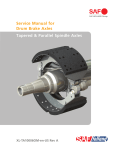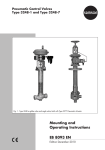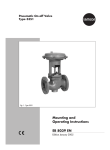Download Mounting and Operating Instructions EB 8113
Transcript
Series V2001 Type 3323 Three-way Valve Mounting and Operating Instructions EB 8113/8114 EN Edition August 2013 Definition of signal words DANGER! Hazardous situations which, if not avoided, will result in death or serious injury WARNING! Hazardous situations which, if not avoided, could result in death or serious injury 2 NOTICE Property damage message or malfunction Note: Additional information Tip: Recommended action EB 8113/8114 EN Contents 1 General safety instructions..............................................................................5 2 Design and principle of operation...................................................................6 3 Installation.....................................................................................................8 3.1 Assembling valve and actuator........................................................................8 3.2 Mounting position.........................................................................................10 3.3 Strainer, bypass............................................................................................10 3.4 Arrangement of the valve..............................................................................10 4 Operation....................................................................................................10 5 Maintenance – Replacing parts.....................................................................12 5.1 Removing the actuator...................................................................................12 5.2 5.2.1 5.2.2 Replacing the packing...................................................................................14 Standard valve bonnet..................................................................................14 Insulating section..........................................................................................16 5.3 5.3.1 5.3.2 Replacing the seat and/or plug......................................................................17 Valves in DN 15 and 25................................................................................17 Valves in DN 32 to 100.................................................................................18 5.4 SAMSON seat wrench and tightening torques...............................................22 6 Description of the nameplate........................................................................23 7 Dimensions..................................................................................................23 8 Customer inquiries.......................................................................................23 EB 8113/8114 EN 3 General safety instructions 1 General safety instructions −− The control valve must be mounted, started up or serviced by fully trained and qualified personnel only; the accepted industry codes and practices are to be observed. Make sure employees or third persons are not exposed to any danger. All safety instructions and warnings given in these mounting and operating instructions, particularly those concerning installation, start-up and maintenance, must be strictly observed. −− The control valves comply with the requirements of the European Pressure Equipment Directive 97/23/EC. Valves with a CE marking have a declaration of conformity which includes information about the applied conformity assessment procedure. The declaration of conformity is available on request. −− To ensure appropriate use, only use the control valve in applications where the operating pressure and temperatures do not exceed the specifications used for sizing the valve at the ordering stage. The manufacturer does not assume any responsibility for damage caused by external forces or any other external factors. Any hazards that could be caused in the valve by the process medium, the operating pressure, the signal pressure or by moving parts are to be prevented by taking appropriate precautions. −− Proper shipping and storage are assumed. WARNING! −− For installation and maintenance, make sure the relevant section of the pipeline is depressurized and, depending on the process medium, drained as well. Depending on the field of application, allow the valve to cool down or heat up to reach ambient temperature before starting any work on it. −− When working on the valve, make sure that the pneumatic air supply or power supply as well as the control signal are disconnected to prevent any hazards due to moving parts. −− Be particularly careful if the actuator springs of pneumatic control valves are preloaded. Such actuators are labeled correspondingly and can also be identified by three long bolts protruding from the bottom of the actuator. Before starting any work on the valve, relieve the compression from the preloaded springs. EB 8113/8114 EN 5 Design and principle of operation 2 Design and principle of operation Fig. 1 The Type 3323 Three-way Valve has a modular design and can be combined with pneumatic or electric actuators (as described in the next section). Depending on the plug arrangement, the three-way valve can be used for either mixing or diverting service. In mixing valves, the process media to be mixed enter at valve ports A and B. The combined flow exits the valve at port AB. In diverting valves, in contrast, the process medium enters at the valve port AB and the partial flows exit at ports A and B. The flow rate from ports A or B to AB and vice versa depends on the cross-sectional area of flow between the seats and plugs. The plug (5, 199) is moved by changing the control signal applied to the actuator. The plug stem (36) is sealed by a spring-loaded PTFE V-ring packing (16) and is connected to the actuator stem by the stem connector. 6 EB 8113/8114 EN Design and principle of operation 7 8 35 2 14 16 54 59 12 2.1 11 36 17 36 74 4 5 A AB 75 199 141 74 192 40 5 4 74 75 74 141 199 B 2 Valve bonnet 2.1Flange 4Seat 5Plug 7 Stem connector 8 Threaded bushing 11Spring 12Washer 14Nut 16Packing 17 Body gasket 35Nut 36 Plug stem 40 Self-locking nut 54Nut 59Crossbeam 74Pipe 75 Pipe (short) 141Seat 192 Retaining washer 199Plug Fig. 1: Type 3323 as mixing valve in DN 32/50; detailed drawing (right) showing the plug arrangement of diverting valve EB 8113/8114 EN 7 Installation 3 Installation Actuator 3.1 Assembling valve and actuator Type 3371 Type 3323PP u EB 8317 EN Type 3372 Type 3323-IP u EB 8313-1 EN u EB 8313-3 EN 1) The valve and actuator are delivered separately and must be assembled on site. There are different ways to assemble the valve and actuator depending on the actuator model and the nominal size. 1) For control valve Associated instructions Version with Type 3725 Positioner Type 3374 Actuator on Type 3323 Valve in DN 65 (NPS 2½) and larger, Fig. 2 The following tables show the actuators that can be used and the associated instructions. 1. Place the actuator yoke on the valve bonnet and fasten using two M8 hexagon socket screws. Types 3371, 3372, 5824 and 3374 Actuators on Type 3323 Valve up to DN 50 (NPS 2), Fig. 3 2. Extend the actuator stem using the manual override until the actuator stem touches the plug stem. Form B attachment (mounting using a central nut) is performed according to the associated Mounting and Operating Instructions. Actuator For control valve Associated instructions Type 3371 Type 3323-PP u EB 8317 EN Type 3372 Type 3323-IP u EB 8313-1 EN u EB 8313-3 EN 1) Type 5824 Type 3323-E1 u EB 5824-1 EN u EB 5824-2 EN 2) Type 3374 Type 3323-E3 u EB 8331-3 EN u EB 8331-4 EN 2) 1) 3. Position the clamps of the stem connector and fasten with screws. Version with Type 3725 Positioner Version with integrated positioner 2) Types 3371 and 3372 Actuators on Type 3323 Valve in DN 65 (NPS 2½) and larger, Fig. 3 Form C attachment (mounting using rods) is performed according to the associated Mounting and Operating Instructions. 8 Fig. 2: Type 3374 in DN 65 and larger EB 8113/8114 EN Installation Form B attachment (mounting using a central nut) 33 35 59 54 Form C attachment (mounting using rods) 7 33 60 2 54 2 Valve bonnet 7 Stem connector 33Rods 35Nut 54Nut 59Crossbeam 60Plate Fig. 3: Form B attachment (mounting using a central nut) and Form C attachment (mounting using rods) EB 8113/8114 EN 9 Operation 3.2 Mounting position 3.3 Strainer, bypass The valve can be mounted in any desired position. However, the restrictions for the actuator used must be strictly observed. We recommend to install a SAMSON Type 2 Strainer upstream of the valve, and upstream of both inlet ports in mixing valves. NOTICE Install the valve free of stress and with the least amount of vibrations as possible. If necessary, support the pipelines near the connections. Since sealing parts, weld spatter and other impurities carried along by the medium may impair the tight shutoff of the seat and plug, flush out the pipeline thoroughly before installing the valve in the pipeline. Pipeline routing To ensure that the control valve functions properly, the pipeline must be straight and without any manifolds or disturbances for a distance of at least 6 times the valve size (DN) upstream and downstream of the valve. Contact SAMSON if this distance cannot be observed. We recommend installing a shut-off valve both upstream of the strainer and downstream of the valve to ensure that the plant does not need to be shut down for maintenance. In addition, install a bypass line. 3.4 Arrangement of the valve Install the valve as shown in Fig. 4 depending on whether it is to be used for mixing or diverting service. Fail-safe action: the valve shuts off the flow of the heating medium or opens the flow of the cooling medium. The plug arrangement (i.e. either mixing or diverting valve) is indicated on a label attached to the valve body. 4 Operation The operating instructions only apply in conjunction with the actuator. Refer to the corresponding Mounting and Operating Instructions. 10 EB 8113/8114 EN Operation Mixing service - Temperature control Q = constant a Flow pipe AB Heating with mixing valve FA Cooling with mixing valve FE A B AB A B Flow pipe Flow pipe f A A AB A AB Flow pipe Flow pipe b) Installation in return flow pipe Heating with mixing valve FA Cooling with mixing valve FE B e a) Installation in flow pipe d Return flow pipe AB Return flow pipe B c) Installation in flow pipe d) Installation in return flow pipe Heating with diverting valve FA Cooling with diverting valve FE e) Installation in return flow pipe Return flow pipe B f) Installation in flow pipe h g Flow pipe Return flow pipe Flow pipe Return flow pipe AB Return flow pipe Return flow pipe Actuator stem extends (FA) Actuator stem retracts (FE) b A B c Diverting service - Flow control Q = 0 to 100 % Flow pipe AB A B A AB Return flow pipe B Heating with diverting valve FA Cooling with diverting valve FE g) Installation in return flow pipe h) Installation in flow pipe Fig. 4: Typical installations EB 8113/8114 EN 11 Maintenance – Replacing parts 5 Maintenance – Replacing parts The control valve is subject to normal wear, especially at the seat, plug and packing. Depending on the operating conditions, check the valve at regular intervals to prevent possible failure before it can occur. External leakage can indicate that the packing is defective. If the valve does not close tightly, tight shutoff may be impaired by dirt stuck between the seat and plug or by damaged facings. 5.1 Removing the actuator Before performing any repair work on the valve, remove the actuator from the valve. Valve up to DN 50 (NPS 2) – Form B attachment (mounting using a central nut), Fig. 5 ÎÎ Undo the screws on the stem connector (7) and remove the stem connector. ÎÎ Unscrew the nut (35) and lift the actuator off the valve bonnet (2). WARNING! Before performing any work on the control valve, make sure the relevant plant section has been depressurized and, depending on the process medium, drained as well. When used at high temperatures, allow the plant section to cool down to ambient temperature. Make sure the electrical or pneumatic control signal for the actuator is switched off. Remove the signal pressure line of a pneumatic actuator. As valves are not free of cavities, remember that residual process medium might still be contained in the valve. We recommend removing the valve from the pipeline. We recommend removing the parts, cleaning them, and, if necessary, replacing them with new ones. 7 35 2 2 Valve bonnet 7 Stem connector 35Nut Fig. 5: Removing actuators from Type 3323 Valve up to DN 50 12 EB 8113/8114 EN Maintenance – Replacing parts Valve in DN 65 (NPS 2½) and larger – Form C attachment (mounting using rods), Fig. 6 ÎÎ Undo the screws on the stem connector (7) and remove the stem connector. ÎÎ Undo nuts (54) while holding the rods (33) stationary with an open-end wrench (SW 22) to prevent them from turning. Valve in DN 65 (NPS 2½) and larger – mounting on yoke, Fig. 7 ÎÎ Undo the screws on the stem connector (7) and remove the stem connector. ÎÎ Unscrew the two hexagon socket screws (S) and lift actuator together with the yoke off the valve bonnet. ÎÎ Lift the actuator including the plate (60) off the valve bonnet (2). 7 33 60 2 7 54 2 Valve bonnet 7 Stem connector 33Rods 54Nuts 60Plate Fig. 6: Removing Types 3371 and 3372 Actuators from Type 3323 Valve in DN 65 and larger EB 8113/8114 EN S 7 S Stem connector Hexagon socket screws Fig. 7: Removing Type 3375 Actuator from Type 3323 Valve in DN 65 and larger 13 Maintenance – Replacing parts 5.2 Replacing the packing Removing the valve bonnet, Fig. 8 Note: Contact your nearest SAMSON subsidiary or the SAMSON After-sales Service department for information on suitable lubricants. Valve up to DN 50 1. Unscrew the threaded bushing (8). 2. Unscrew nuts (14) and lift off flange (2.1). Valve in DN 65 and larger 1. Unscrew the threaded bushing (8). 5.2.1 Standard valve bonnet In case of leakage at the packing, the packing (16) must be renewed. 2. Unscrew nuts (14) and lift the valve bonnet (2) off the valve body over the plug stem. 3. Check the body gasket (17) located in the valve body for damage. We recommend renewing the body gasket. Up to DN 50 DN 65 and higher 36 36 16 35 12 16 2 17 8 8 14 11 2 14 17 2.1 2 Valve bonnet 2.1Flange 8 Threaded bushing 11Spring 12Washer 14Nut 16Packing 17 Body gasket 35Nut 36 Plug stem Fig. 8: Valve bonnet 14 EB 8113/8114 EN Maintenance – Replacing parts 4. Use a suitable tool to pull the damaged packing (16) out of the valve bonnet. Remove washer (12) and spring (11) and clean the packing chamber. 8 Installing the packing, Fig. 9 5. Apply a suitable lubricant to each part of the new packing as well as to the plug stem. 16 6. Insert the spring (11) and then the washer (12) into the packing chamber. 7. Carefully slide the parts of the new packing (16) into the packing chamber. 12 8. Apply a suitable lubricant to the thread of the threaded bushing (8). Lightly screw in the threaded bushing, but do not tighten it yet. 11 Mounting the valve bonnet 2 Valve up to DN 50 9. Place the valve bonnet (2), while turning it, over the plug stem (36) onto the valve body. Make sure that the body gasket (17) is seated properly. 10.Place the flange (2.1) on the bonnet and fasten it with the nuts (14) (observe tightening torque listed in Table 1). Tighten the threaded bushing. Valve in DN 65 and larger 9. Place the valve bonnet (2), while turning it, over the plug stem (36) onto the valve body. Make sure that the body gasket (17) is seated properly. 10.Fasten the bonnet with the nuts (14) (observe tightening torque listed in Table 1). Tighten the threaded bushing. EB 8113/8114 EN 2 Valve bonnet 8 Threaded bushing 11Spring 12Washer 16Packing Fig. 9: Packing parts 15 Maintenance – Replacing parts 5.2.2 Insulating section Fig. 10 The insulating section is used to extend the distance between the packing and the valve as well as the process medium. This results in a wider temperature range. Up to DN 50 The arrangement of the packing in the insulating section is the same as in the standard bonnet. Proceed as described in section 5.2.1 to replace the packing. DN 65 and higher 36 36 8 8 35 16 12 11 16 2 12 11 14 2.1 14 17 2 Valve bonnet 2.1Flange 8 Threaded bushing 11Spring 12Washer 14Nut 16Packing 17 Body gasket 35Nut 36 Plug stem Fig. 10:Insulating section with packing 16 EB 8113/8114 EN Maintenance – Replacing parts 5.3 Replacing the seat and/or plug Valves in DN 15 and 25 can be used both as mixing or diverting valves. The direction of flow is the only factor in this case that determines the application. Therefore, it is not necessary to rearrange the valve. The valve construction only has one plug. able tool and undo the nut (40) from below. 5. Remove the retaining washer (192) from below. 6. Carefully pull the plug stem out of the body from above. 7. Unscrew the top seat (4) using a seat wrench. Valves in DN 32 and larger have two plugs. Their arrangement differs depending on whether the valve is to be used as mixing or diverting valve. When checking or replacing the seat or plug, we also recommend replacing the packing (16) and the body gasket (17). When disassembling the valve, it is important to lay out the parts in the exact order they were disassembled in to facilitate assembly later. Refer to Table 1 for the required tightening torques for seats (4, 141) and nuts (14, 40) on the body and plug stem. 36 8 16 2 14 17 2.1 4 5 192 40 141 5.3.1 Valves in DN 15 and 25 Disassembly, Fig. 11 1. Unscrew threaded bushing (8), remove nuts (14) and lift off flange (2.1). 2. Lift the valve bonnet (2) off the valve body over the plug stem. 3. Check the body gasket (17) located in the valve body for damage. We recommend renewing the body gasket. 4. Hold the plug stem (36) stationary from above at the hexagonal part with a suitEB 8113/8114 EN 2 Valve bonnet 4Seat 5Plug 8Threaded bushing 14Nut 16Packing 17 Body gasket 36 Plug stem 40 Self-locking nut 141Seat 192 Retaining washer Fig. 11:Seats and plug for DN 15 and 25 17 Maintenance – Replacing parts 8. Once the plug (5) has been removed, the bottom seat (141) can also be removed using the seat wrench. 9. Carefully clean all the parts and renew them, if necessary. Assembly Proceed in the reverse order to assemble the parts: Valve bonnet (DN 65 and larger) 1. Unscrew the threaded bushing (8). 2. Remove nuts (14) and lift the valve bonnet (2) off the valve body over the plug stem. Check the body gasket (17) located in the valve body for damage. We recommend renewing the body gasket. 1. Mount bottom seat (141). Mixing valve 2. Insert the plug (5) with the three skirt projections facing upwards. 3. Hold the plug stem (36) stationary from above at the hexagonal part with a suitable tool and undo the nut (40) from below. 3. Mount top seat (4). 4. Guide the plug stem (36) from above through the plug (5). 5. Place the retaining washer (192) on the plug stem and mount the nut (40). 6. Apply a suitable lubricant to the plug stem in the area where the packing is located. 7. Carefully place the valve bonnet (2) over the plug stem (36) onto the valve body. 8. Place on flange and fasten with nuts (14). 9. Apply a suitable lubricant to the thread of the threaded bushing (8). Mount bushing. 5.3.2 Valves in DN 32 to 100 Disassembly, Fig. 8 and Fig. 12 Valve bonnet (DN 32 and 50) 4. Remove the retaining washer (192) and pipe (74) from below. 5. Carefully pull the plug stem (36) out of the body from above, while removing the short pipe (75) sideways. 6. Unscrew the top seat (4) using seat wrench (see Table 1). 7. Remove the top plug (5) and bottom plug (199) from the valve body. 8. Unscrew the bottom seat (141) using seat wrench. 9. Carefully clean all the parts and renew them, if necessary. Diverting valve 3. Hold the plug stem (36) stationary from above at the hexagonal part with a suitable tool and undo the nut (40) from below. 1. Unscrew the threaded bushing (8). 2. Remove nuts (14) and lift off flange (2.1). 18 EB 8113/8114 EN Maintenance – Replacing parts Mixing valve Diverting valve 36 32 5 74 4 74 4 5 199 75 141 75 141 74 199 192 40 DN 32 and 50 DN 32 and 50 36 5 75 74 4 4 74 74 141 40 141 40 199 199 192 192 DN 65 and higher 4Seat 5Plug 36 Plug stem 5 75 DN 65 and higher 40 Self-locking nut 74Pipe 75 Pipe (short) 141Seat 192 Retaining washer 199Plug Fig. 12:Plug arrangement for valves in DN 32 to 100 EB 8113/8114 EN 19 Maintenance – Replacing parts 4. Remove the retaining washer (192) and pipe (74) from below. Carefully pull the plug stem out of the body from above. The pipes (74, 75) for fixing the plug in place will now fall off the plug stem. 5. Slide the bottom pipe (74) and retaining washer (192) from below onto the plug stem and tighten the nut (40), while holding the plug stem stationary. Observe the tightening torque in Table 1. 5. Remove the top plug (5) from the valve body. Diverting valve 6. Unscrew the top seat (4) and then the bottom seat (141) using a suitable seat wrench (see Table 1). 7. Remove the bottom plug (199) from the valve body. 8. Carefully clean all the parts and renew them, if necessary. Mounting the seat/plug Apply a suitable lubricant to the thread and the sealing cone of the new or remachined seats as well as to the nuts (40) and the threaded end of the plug stem. On mounting the spacer pipes and plug, use a rod or long screw to hold them in position. Mixing valve 1. Screw in the bottom seat (141) using seat wrench. Observe the tightening torque in Table 1. 2. Insert the bottom plug (199) into the seat (141) and hold the pipe (74) and the top plug (5) from below using a rod. 3. Mount top seat (4) with the seat tool. 4. Slide the pipe (74) on the plug stem and push the plug stem from above through the top plug (5), pipe (75) and bottom plug (199), while removing the rod (used as a tool) from below out of the valve. 20 1. Place the bottom plug (199) in the valve body as shown and mount the bottom seat (141) using a seat wrench, observing the tightening torques in Table 1. 2. Capture the bottom plug (199) and pieces of pipe (74, 75) using the rod as a tool. 3. Mount the top seat (4) using the seat wrench and applying the tightening torque in Table 1. 4. Place the top plug (5) in the top seat (4). 5. Guide the plug stem (36) from above through the plug (5), spacer pipes (74, 75) and bottom plug (199). 6. Place the retaining washer (192) from below on the plug stem and mount the nut (40), while holding the plug stem stationary. Observe tightening torque in Table 1. Mounting the valve bonnet 1. Apply a suitable lubricant to the plug stem (36) in the area where the packing is located. 2. Carefully place the valve bonnet (2) over the plug stem onto the valve body. EB 8113/8114 EN Maintenance – Replacing parts Valve up to DN 50 Valve in DN 65 and larger 3. Place flange (2.1) on the bonnet and fasten with the nuts (14) (observe tightening torque in Table 1). 3. Fasten the bonnet with the nuts (14). 4. Apply a suitable lubricant to the thread of the threaded bushing (8). Screw in the threaded bushing and tighten it. 4. Apply a suitable lubricant to the thread of the threaded bushing (8). Screw in the threaded bushing and tighten it. Up to DN 50 DN 65 and higher 36 36 8 2 2 14 14 2.1 2 Valve bonnet 2.1Flange 8 Threaded bushing 14Nut 36 Plug stem Fig. 13:Bonnet EB 8113/8114 EN 21 Maintenance – Replacing parts 5.4 SAMSON seat wrench and tightening torques Contact the SAMSON After-sales Service for more details on mounting. Table 1: SAMSON seat wrench and tightening torques Nominal size DN 15 to 25 NPS ½ to 2 DN 32 to 50 NPS 1½ to 2 DN 65 to 80 NPS 2½ to 3 DN 100 NPS 4 Seat wrench Order no. 1280-3010 1280-3011 1280-0305 1280-0405 9932-3814 9932-3808 9932-3812 9932-3808 9932-3814 9932-3808 9932-3814 120 Nm M62 x 1.5 500 Nm 950 Nm 880 Nm 120 Nm M68 x 1.5 500 Nm 1400 Nm 1320 Nm 30 Nm 50 Nm 100 Nm 150 Nm Additionally required Seat thread tightening torque ±10 % Top Bottom Body nuts (14) tightening torque ±10 % 22 EB 8113/8114 EN Description of the nameplate 6 Description of the nameplate 1 2 3 -4 5 7 9 11 12 6 8 10 13 14 Made in Germany SAMSON Fig. 14:Nameplate 1 CE marking or "Art. 3, Abs. 3", where applicable 2 ID of the notified body, fluid group and category, where applicable 3 Type designation 4 Device modification index 5Material 6 Year of manufacture 7 Valve size: DIN: DN, ANSI: NPS 8 Perm. operating gauge pressure at room temperature, DIN: PN, ANSI: CL 9 Order no. with modification index 10 Item in order 7 Dimensions The dimensions for the DIN and ANSI versions of the Type 3323 Valve can be found in the associated Data Sheets u T 8113 EN and u T 8114 EN 8 Customer inquiries Submit the following details when making inquiries: −− Order number and item in the order (written on the nameplate) −− Type, nominal size and nominal pressure of the valve −− Pressure and temperature of the process medium −− Flow rate in m³/h −− Bench range of the mounted actuator (e.g. 1.4 to 2.3 bar) −− Strainer used −− Installation drawing 11 Flow coefficient: DIN: KVS, ANSI: CV 12 Characteristic: % equal percentage, Lin linear, DIN: A/Z, ANSI: O/C for on/off 13Seal: ME metal, ST Stellite coated, Ni nickel plated, PT soft PTFE seal, PK soft PEEK seal 14Version: M mixing valve, V diverting valve EB 8113/8114 EN 23 Weismüllerstraße 3 · 60314 Frankfurt am Main, Germany Phone: +49 69 4009-0 · Fax: +49 69 4009-1507 [email protected] · www.samson.de EB 8113/8114 EN 2014-07-11 SAMSON AG · MESS- UND REGELTECHNIK
























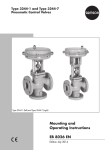
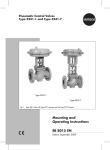
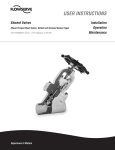
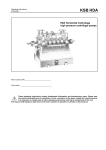
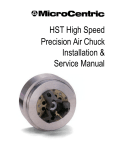
![United StiltBS Patent [19] [11] Patent Number: 5,025,556](http://vs1.manualzilla.com/store/data/006008181_1-2c5f49b6565f7d3a6ea1501cb683eb1f-150x150.png)

